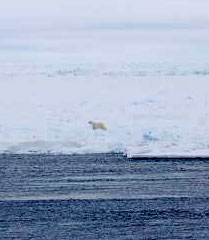

 | |||||||||||||
|
|
Journals 2007/2008Kathy Couchon
June 2, 2007 Latitude/Longitude: 81°20.0' N, 011°57.0' E My day started a bit later than usual this morning, as I had been up until after 0200 with the tests for the JAGUAR autonomous underwater vehicle. By the time I went downstairs for some strong Swedish kaffe, other test runs were already underway. The CAMPER unit had been in the water for two hours according to my teacher colleague, Dietmar Gruber. Dietmar is from Karlsruhe, Germany and has been invited onboard the Oden by the Swedish Polar Research Secretariat; he is taking part in the European Education Gateway program. We have been busy with our respective team duties, Dietmar with CAMPER and I with the AUVs, JAGUAR and PUMA. When we are not working with our teams, we often spend time discussing and planning potential collaborative projects for our students for the next school year. Other times are spent talking with and learning from the various scientists on board, all with the goal of taking valuable current science research methods and data back to our schools. It seems that school is always in session for these teachers! We met on deck with microbiologist, Elisabeth Helmke, from the Alfred Wegener Institute in Bremerhaven, Germany. She was excited to have just found out that a coring unit will be attached to CAMPER and will be used to collect sediment samples for her. Elisabeth is studying the microbial populations in the hydrothermal vents. Dietmar and I discussed with Elisabeth the possibility of looking for microbes in the ice and so we took turns throwing a bucket overboard and scooping up seawater and small ice chunks. It was a fairly crude method of collection, but you do what you must in the name of science. In the container that functions as her lab, Elisabeth allows us to use her equipment to measure the salinity of the melted sea ice chunks and the surrounding seawater. The salinity of the ice is, as we predicted, lower than that of the seawater; the ice was 10.5 ppt and the seawater, 37 ppt. As sea water freezes, the ice crystals form and leave the salts behind in the water, increasing its salinity. We are also grateful to Elisabeth for preserving our water samples, so that we make take them home. Our students will be able to observe them for microbes that may have been living in either the ice or surface waters. Did I mention that today was one of those quite rare days in the Arctic when you experience brilliant sunshine? Everywhere you look, sunlight is reflecting off of the open water and ice crystals. The sun feels so warm when you are out of the breeze that you could bask in it and feel that it really is springtime, when all around you the landscape is clearly winter-like. Crew members took advantage of our stop on location to do some skeet shooting off the aft deck. We hope that the shotguns will be used only for clay pigeons and not for protection from polar bears. On my last expedition to the Arctic in 2004, I took part in a major drilling expedition, and I wonder now what scientists would have thought if clay pigeon fragments had come up in the sediment cores. Later in the day, quite after the guns were put away, we were on the move again to a new location. At this site, my second polar bear sighting was made. The bear wandered around on the ice floes, a bit of a distance from us, yet seeming to watch us carefully. During this time the ship was busy turning around, all the while breaking ice to create a "pond" for deploying the vehicles. All of this ship movement made it difficult to keep eyes and cameras focused on the bear while it meandered among and behind the pressure ridges on the ice. After a time, it tired of us and took off, I suppose, for a more attainable meal. At this new open water site, the plans called for mooring, or securing the ship to the ice to allow a variety of tests to be run simultaneously. One particularly interesting test will be a "melting ice rescue and recovery" procedure tomorrow. These autonomous underwater vehicles we are testing have never been used in the cold Arctic waters and when one is set off on its course, there is the possibility that something may malfunction and it may wander and be lost under the 1-3 meter thick pack ice. If this happens, there must be a method to retrieve the vehicle. The AUVs are equipped with an "avalanche beacon", the kind used to find skiers or hikers lost in an avalanche. This will enable the scientists to locate the AUV under the ice, but then, how to retrieve it if it is meters or kilometers from open water? That is where the ice melting would come in. It is expected that sometime tomorrow, some of the science party will go off in the helicopter to a site on the ice where they will test this method.
|
||||||||||||

